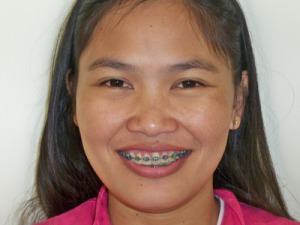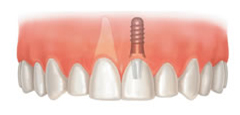
What is orthodontics?
Orthodontics is the dental specialty that focuses on the development, prevention, and correction of irregularities of the teeth, bite, and jaws. Orthodontists also have specialized training in facial abnormalities and disorders of the jaws. A patient may consult an orthodontist after receiving a referral from his or her general dentist recommending orthodontic treatment to improve the patient’s physical “orofacial” appearance. However, the American Dental Association recommends that every child receive an orthodontic evaluation by the age of seven.
Why choose orthodontic treatment?
Any orthodontic problem may be classified as a malocclusion, or “bad bite.” The following problems may be helped or minimized with proper orthodontic treatment:
-Misaligned, or crowded teeth
-Missing teeth
-Extra teeth
-An overbite
-An open bite
-Misaligned or incorrect jaws position
-A disorder of the jaw joint
At what age do braces become appropriate?
Moving and correcting the alignment of the teeth follows the same biological and physical process no matter what the age is. However, an adult mouth must overcome already positioned facial bones and jaw structure. Thus, overcoming most types of malocclusions may require more than one type of orthodontic treatment for adults. In most cases, the ideal age for braces and other orthodontic treatments is between 10 and 14 years of age, although people of any age can benefit from treatment.
What are the different types of braces available?
Braces, also called fixed orthodontic appliances, generally come in three varieties:
-Brackets, metal or ceramic, clear or tooth-colored, that are bonded to teeth
-Lingual-type brackets that attach to the back of teeth, hidden from view
-Bands that cover most of the teeth with metal bands that wrap around the teeth
All three types use wires to move the teeth to the desired position.
Oral healthcare and braces
The following recommendations will help to eliminate, or reduce, any oral health problems while your teeth are in braces:
-Brush your teeth carefully after every meal with fluoride toothpaste and a soft-bristled toothbrush, as food becomes easily lodged in the braces. A new toothbrush may be needed every three to four months or sooner if bristles are broken or frayed. A worn toothbrush doesn’t do a good job of cleaning the teeth.
-Floss daily between the teeth and the braces.
-Rinse your mouth daily by a mouthwash recomended by your orthodontist.
-Visit your dentist for cleanings every four to five months.
-Limit your sugar and starch intake, as debris left behind from these types of foods may turn into damaging acids, which, in addition to promoting plaque formation, may also be harmful to teeth and gums.
-Avoid hard and/or sticky snacks that may be difficult to remove from the orthodontic equipment in your mouth. This includes hard foods such as popcorn, hard candy, nuts, and sticky foods like chewing gum, caramel, and other chewy candy.
-Ask your dentist about the application of a fluoride varnish around the braces to minimize white spots on the teeth after the braces come off.
Othodontic Removable Appliances
What are removable orthodontic appliances?
Contemporary orthodontic treatment involves the use of both fixed and removable appliances. Fixed appliances, also known as braces, form a major part of the orthodontic treatment. Although removable appliance play only a supporting role in comprehensive treatment, they are important in the orthodontic treatment of children.
Removable appliances are appliances, which can be easily removed and reinserted into mouth. They consist of wires and screws held together by a plastic base and are used to move teeth and jaws into better relationships using gentle force.
What are the uses of these appliances?
They are useful when small amount of orthodontic correction is required.
It is sometimes possible to change the way the jaws grow, using orthodontic appliances. A special kind of removable appliance called functional appliance harness the power of the jaw muscles and can help with certain types of problem.
After tooth movement using braces is complete, a retainer (which is a kind of removable appliance) must be worn to hold the teeth and jaws in their new and proper position. The retainer must be worn for approximately one year to help prevent the teeth or jaws from falling back to its original or starting position.
What are the parts of a removable functional appliance?
The removable appliance consists of an active element or elements (i.e. metal wires and/or screws), which exert orthodontic forces on the teeth, and retentive elements (i.e. clasps), which help, in retaining the appliance in the mouth. A plastic plate holds these two sets of elements together. It is more commonly used in the correction of teeth in the upper jaw.
How are the appliances made?
Unlike braces the removable appliances are made in the dental lab. A plaster model is created from an impression of the patient’s jaw, over which the appliance is designed and made. The finished appliance is then fitted on the patient.
What are the advantages of using a removable appliance?
-It is inexpensive
-It is relatively simple to adjust, requiring little clinical time.
-If the appliance causes any irritation the patient can remove it.
-It can be removed for cleaning; therefore oral hygiene is seldom a problem.
-It may be removed for contact sports; therefore damage to the patient (and appliance) is reduced to a minimum.
What are the disadvantages of using a removable appliance?
-It tends to be rather bulky and takes some time to get used to.
-It is unsuitable for most treatment in the lower arch, as the shape of the lower teeth does not allow the appliance to be satisfactorily retained.
-Removable appliances can only carry out tipping movements and other drastic movements like the complete rotation of the tooth is not possible.
-Co-operation of the patient is very essential for the success of the treatment.
-Results occur much slower when compared to Braces.
How are removable appliances maintained?
-It must be worn constantly to derive early and good results.
-When outside the mouth it should be stored in a cup of cold water. Exposure to heat can alter the shape and fitting of the appliance.
-It should be removed in advance before any contact sports and during meals.
-The appliance has to be removed and inserted carefully to avoid breaking the plastic or deforming the wires.
-The appliance has to be kept clean. A toothbrush is convenient for this purpose.
Invisalign
Invisalign takes a modern approach to straightening teeth, using a custom-made series of aligners created for you and only you. These aligner trays are made of smooth, comfortable and virtually invisible plastic that you simply wear over your teeth. Wearing the aligners will gradually and gently shift your teeth into place, based on the exact movements your dentist or orthodontist plans out for you. There are no metal brackets to attach and no wires to tighten. You simply pop in a new set of aligners approximately every two weeks, until your treatment is complete and you achieve the confident smile that you’ve always wanted. The best part about the whole process is that most people won’t even know you’re straightening your teeth.








